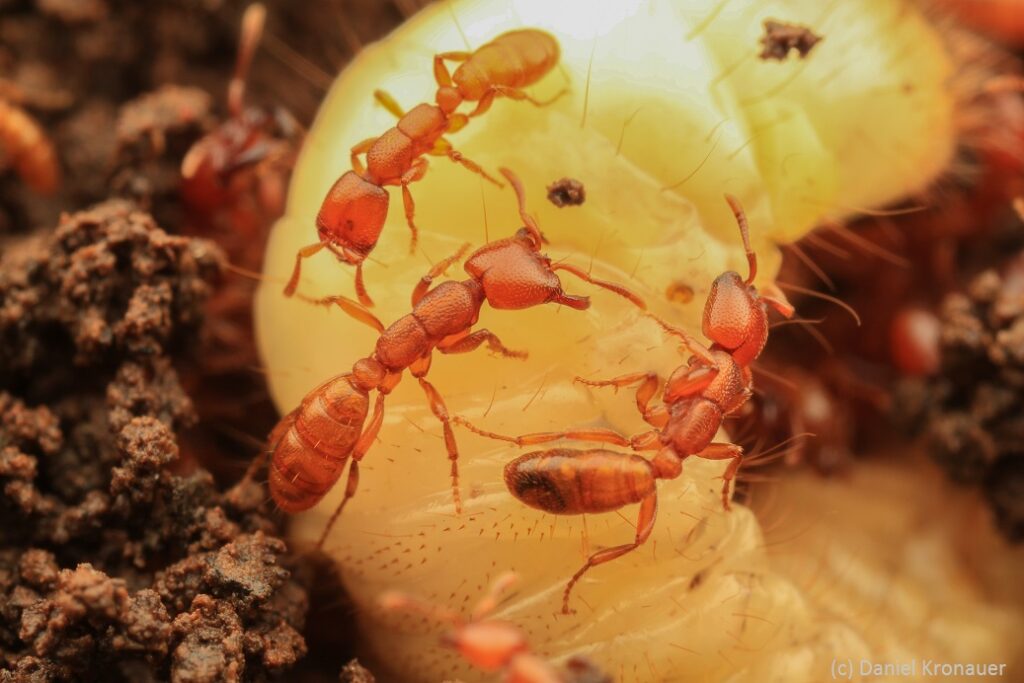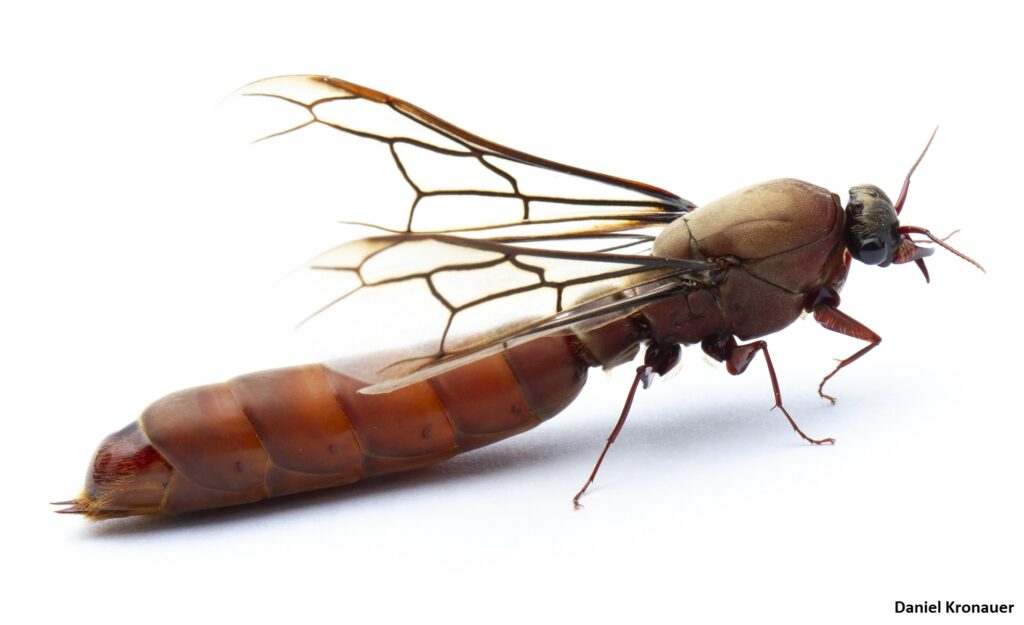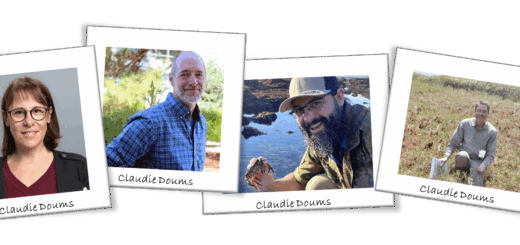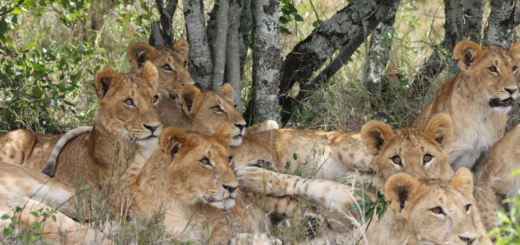Male-worker but not male-queen morphological differences in the head of the ant Dorylus helvolus

In the recently published article “Anatomy and evolution of the head of Dorylus helvolus (Formicidae: Dorylinae): Patterns of sex- and caste-limited traits in the sausagefly and the driver ant” published in the Journal of morphology, Brendon Elias Boudinot, Olivia Tikuma Diana Moosdorf, Rolf Georg Beutel, and Adrian Richter compare males, queens, and worker of the ant Dorylus helvolus. The authors revealed that the males shared no morphological features with workers, workers shared numerous features with queens, and a set of features were unique to the queens and males, including a derived mandibular form. Here, Brendon Boudinot and Olivia Moosdorf highlight the main points and answer some questions.
An interview compiled by Patrick Krapf, Felix Oberhauser, Lina Pedraza

The pictures and the video are partially from Daniel Kronauer’s book “Army Ants: Nature’s Ultimate Social Hunters” (© Daniel Kronauer)
MNB: Could you tell us a bit about yourself?
Together: We are a team of ant folks working together to drill down on the tiniest, micron-scale details of ant anatomy for biomechanical and evolutionary study. Olivia started this project as a Bachelor student advised by Adrian and Rolf, and Brendon came in as a post-doc. We were struck by the lack of information on sexual dimorphism in ants and the Hymenoptera more broadly.
OTDM: I am a Master student for “Evolution, Ecology and Systematics” at the Friedrich-Schiller-Universität Jena. I found my interest in entomology during the end of my Bachelor studies and decided to do my thesis at the zoological institute. Prof. Dr. Rolf Beutel, Prof. Dr. Hans Pohl, and especially Adrian Richter introduced me to the subject and supervised my thesis on the male Dorylus-head.
BEB: I am an ant systematist and insect anatomist currently at the Friedrich-Schiller-Universität Jena as an Alexander von Humboldt Research Fellow. I completed my PhD last year under Dr. Phil Ward’s supervision at the University of California, Davis, where I worked on ant taxonomy and phylogenetics, male ant morphology, the interordinal homologies of male insect genitalia, and the evolution of the ants in the broader context of the Aculeata. My present objective is to study the “terrestrialization” of ants and other Hymenoptera, i.e., the adaptation of the locomotory systems for walking and running from a flight-optimized ancestor.
MNB: Could you briefly outline the research you recently published in layman’s terms?
BEB: In our article, we atlased the head anatomy of the male of the army or driver ant, Dorylus helvolus. We made two sets of comparisons: First, to the external anatomy of conspecific and closely related workers and queens, and second to the internal anatomy to a phylogenetically diverse sample of ant species. In other words, we compared the externally visible features among the castes of a single species or closely related species, and internal anatomy across a range of more distantly related taxa. This is the first detailed study of the head anatomy of any male ant. We conducted the work as holistically as possible, and we tried to consider the observed anatomical features from the developmental, phylogenetic, and functional perspectives.
Anatomically, we found that the male pharyngeal (sucking) apparatus differs in its organization from females. Also, we found two unique muscles in the male that were not previously observed in ants. These two unique muscles could be present generally among male ants, but a greater sampling of males is necessary. To our surprise, males and queens of Dorylus shared several traits not found in workers, while workers and queens shared many other characteristics absent in males, and no trait was shared between males and workers. Except for the flight apparatus, almost no features have been documented to be shared exclusively by queens and males but not workers. We considered the possible causes and hypothesized that a strong sexual selection on the copulatory clamping function of the male mandibles might have led to the derivation of a distinct, falcate (curved) mandibular form which is expressed both in males and queens. Further, we postulated a set of developmental processes which might explain mandible patterning in ants and other Aculeata, and proposed a set of hypotheses to explain the derived head shape of male army ants. Finally, we advocate the consideration of pore patterning for sensilla classification, as pore presence/absence and location is both functionally significant and, with the addition of other histological details, more consistent for sensilla identification than external shape alone.


MNB: What is the take-home message of your work?
BEB: Our understanding of ant morphology, development, and evolution is incomplete without considering males. Specifically, phenotypic plasticity in ants is more complicated than in other animals because of the obligate expression of three castes in non-parasitic species: Workers, queens, and males. Do males retain plesiomorphies that are not expressed in females? Can this be a source of variation for female ant evolution? Sexual selection may be tied to social complexity, but there is too little focus on males to draw conclusions as of yet. More broadly, what can we learn about the “domestication” of the male and queen castes, i.e. the process of selection resulting in behaviorally, anatomically, and physiologically specialized reproductives from generalist ancestors without pronounced intercaste polyphenism? For example, the reproductives of doryline army ants are exceptionally massive relative to their workers, while non-army-ant dorylines (the former “Cerapachyinae”) have roughly similar-sized workers, queens, and males. Whereas male ant mandibles are generally “spandrels” or non-functional structures, the pattern is reversed in in doryline army ants, where the mandibles of males are highly functional and those of queens are vestigial. There are certainly other patterns to dissect, so we must turn at least some of our attention to the forgotten phenotype: the male.
OTDM: As Brendon suggested, we should continue to document male anatomy, make explicit comparisons to conspecific workers and queens, and focus on male-specific traits. While male ants may be economically “useless” for the colony, their potential for deepening our understanding of ants is becoming clearer.
MNB: What was your motivation for this study?
OTDM: It started with Prof. Dr. Rolf Beutel telling me about giant male ants known as “sausage flies” and with the fun came the curiosity. One of my motivations was to learn how to make high-quality segmentations, that is, how to label raw µ-CT scan data for 3D modeling, and how to use these models for scientific research.
BEB: I followed up on Olivia’s beautiful models and renders by making the inter-caste comparisons and attempting to anchor our observations in development and phylogeny.
MNB: What was the biggest obstacle you had to overcome in this project?
OTDM: I am not sure how to say it, but stop overdoing the segmentation and start writing! There is so much to read about army ants (thank you Dr. Daniel Kronauer!), but sometimes the writing needs to get done.
BEB: Trying to understand morphology at the developmental level. I needed a lot of time to read and consider the literature, and we could not have come to our understanding of Dorylus without a direct conversation with Drs. Rajendran Rajakumar, Buck Trible, and Daniel Kronauer, plus exchanging some ideas with Dr. Heather Bruce. I hope that no serious flaws will be found in our thinking in the years to come. Any mistakes in reasoning are ours alone.
MNB: Do you have any advice for others who are interested in doing related research?
OTDM: It is always good to be detail-oriented. I also learned that if you do not know something, it is better to ask, as someone always has an idea. Even though this may be obvious, teamwork is crucial.
BEB: Not a tip, but I recommend the further use of comparative systematic methods to study the evolution of sexual and inter-caste polyphenism. Few other studies have approached the question of ant polyphenism from the perspective of systematics, i.e., tabulating a detailed list of comparative observations for analysis, as is done in morphological cladistics or phylogenetics. From what I have seen through the microscope, many patterns have simply never been put into words. The discovery phase, I think, will be worth pursuing. Also, I think that conceiving anatomical structures developmentally will be transformative for morphological phylogenetics, which is critical for incorporating fossils into our understanding of ant evolution.
MNB: Where do you see the future for this particular field of ant research?
OTDM: The morphology of male ants has been under the radar for way too long. Researchers like Brendon, and others such as Dr. Marcio Pie and Raquel Divieso, try to change the perspective by looking at the males. I think and hope that more researchers will join to help advancing the understanding we have about ant morphology and evolution.
BEB: Ant morphology, as a field, will become more comprehensive in scope. We will, I hope, routinely consider developmental causes for the patterns we observe across species and higher taxa. Through the use of µ-CT data we will, I think, realize the potential of phenomics for phylogenetic and evolutionary studies.



A video of how Daniel Kronauer and his team excavate a Dorylus colony





It was published in august 2021….